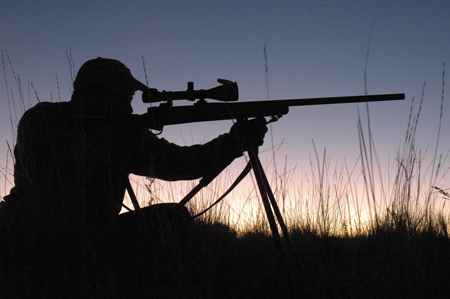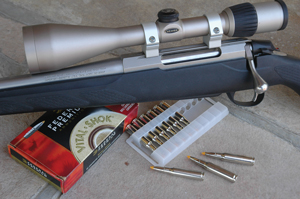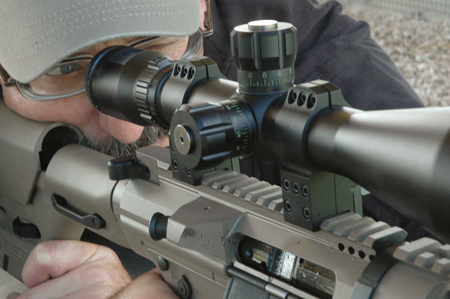 Bright glass (here in a Leupold) can salvage a hunt when your only shot comes in dim light! |
Since its start in 1974, Aimpoint has worked to offer the best red dot sights. Early on, that was easy, because red dot sights were then new. In fact, Gunnar Sandberg’s first “single-point sight” had no optical tunnel. You couldn’t look through this sight; you looked into the tube with one eye while your other registered a dot superimposed on the target. Sandberg refined the device and founded Aimpoint to produce it.
Hunters liked the illuminated dot, suspended in a wide field they could see from almost any place behind the sight. The front lens of a modern Aimpoint is a compound glass that corrects for parallax – unlike most red dot sights, whose reflective paths shift with eye position. Aimpoint’s doublet brings the dot to your eye in a line parallel with the sight’s optical axis, so you hit where you see the dot, even when your eye is off-axis. A 1x Aimpoint gives you unlimited eye relief too. Advanced circuitry on the newest models reduces power demand. Batteries last up to 50,000 hours with a mid-level brightness setting.
 This Weaver Grand Slam scope, one in a big stable of fine variables, tops a Tikka T3 rifle. |
The lightest of Aimpoint’s 9000 series weighs just 6.5 ounces. Each windage and elevation click moves point of impact 13mm at 100 meters. The newest Hunter series comprises four models: long and short tubes, 34mm and 30mm in diameter. They all feature 1x images, 2-minute dots, half-minute clicks. A 12-position dial lets you fine-tune dot intensity – low for dim light, high under sunny skies. One CR-2032 battery lasts five years if you never turn the sight off! Hunter sights are waterproof. Fully multi-coated lenses (43mm up front on the 30mm sight, 47mm on the 34mm tube) deliver a sharp image, and as with all Aimpoints, the internal design gives you unlimited eye relief with zero parallax.
Sturdy enough for military use, Aimpoints have been adopted by armed forces in the U.S. and France. They serve sportsmen in forty countries. One of every ten moose hunters using optical sights in Sweden carries an Aimpoint. I’ve killed moose with these optics in dark timber, then shot golf-ball-size groups on paper at 100 yards. The company’s line includes a Micro H1, ideal for bows and handguns. (Aimpoint.com.)
A young optics company, Alpen has surprised everyone over the last few years with “great buy” credits from such venerable sources as Outdoor Life. While 2010 brings only a few new products to the catalog, many established optics in the Alpen line deserve another look. In short-summary fashion, then:
The Rainier 20-60×80 spotting scope accommodates a camera adapter for photography at long range. AR riflescopes for air guns were designed to endure double-shuffle recoil. Carriage-class Rainier binoculars now come in 8×32 and 10×32 versions that are 20 percent lighter than the 42mm originals but still wear BAK4 lenses, phase-corrected coatings, a locking diopter dial and twist-out eyecups. The AlpenPro Porro series includes an 8×30 that’s ideal for the woods. Alpen’s energetic Vickie Gardner is busy “scrambling to fill back-orders from 2009!” Why? “Alpen offers great value; the riflescopes and binoculars truly are great buys.”
Also, some 2009 introductions were premature; stock didn’t arrive until late in the year. Wings binoculars, for example. Choose 8×42 or 10×42, with ED glass as an option. The 8×42 has impressed me in the field; so has a new Apex rifle-scope on a bolt-gun in the rack. The four Apex sights just cataloged include three with turret-mounted parallax dial and new bullet-drop-compensating reticle. “We’ve also upgraded our 20-60×80 spotting scope with a fine-focus knob,” says Vickie. Shift focus quickly with the standard dial, then refine the image with this new adjustment. (Alpenoutdoors.com.)
While Barrett is known for its 50-caliber rifles, it also markets an optic that helps shooters hit at long range. The Barrett Optical Ranging System – BORS – is a sight attachment, a 13-ounce device you pair with a scope. It incorporates a small ranging computer powered by a CR-123 lithium battery. There’s a liquid crystal display with a four-button keypad. Factory-installed cartridge tables tailored to your loads enable the computer to deliver precise holds for long-distance shooting. The BORS includes an elevation knob and a knob adapter. A set of steel rings mounts the unit to any M1913 rail and are secured with hex nuts that endure the beating from Barrett rifles in .50 BMG. Press the 6-o’clock power button, and you’re ready to engineer a shot. The screen shows your zero or sight-in range and indicates any cant (tipping of the rifle), which at long range can cause you to miss.
To determine range, you specify target size, then move the horizontal wire of your reticle from top to bottom on the target. The range appears in yards or meters. Now you can use the elevation knob to dial the range. The BORS unit must know your load, of course. You provided that data earlier; the unit stores it as a ballistics table. It can hold up to 100 tables for instant access. At the end of this process – which takes longer to explain than to do – you can hold dead-on at any range. The BORS automatically compensates for vertical shot angles. You can adjust the scope for up to 90 degrees of inclination and declination, in increments of 2 degrees. Temperature and barometric pressure come on-screen when you press the 9-o’clock button. If the battery dies, you can use the scope as if the electronics were not there. Paired with a Leupold Mark 4 LR/Tactical 4.5-14×50 scope, the BORS unit on my Barrett rifle shrugs off the .50’s blast and recoil. (Barrettrifles.com.)
When variables started to gain traction with hunters, the 3-9x became the logical leader. Not only did 3x afford fast sighting; 9x was all you needed for any big game – and even coyotes at long range. The three-times power range seemed adequate. As shooters chased power, though, four-times magnification appeared, in 3-12x and 4-16x 30mm scopes. Burris was among the first with six-times magnification. Its 2-12x scope is surely versatile! Like the Euro Diamond and Black Diamond lines, both Six Series sights (40mm and 50mm up front) feature 30mm tubes and 4 inches of eye relief. Signature Select and Fullfield II models have 1-inch tubes.
The Fullfield II 6×40 and 3-9×40 have impressed me as fine values – also the 2-7×35. Burris Ballisic Plex and Ballistic Mil-Dot reticles are available in the Euro Diamond and Black Diamond scopes, and the Signature Select and Fullfield II lines. Illuminated reticles define the Fullfield II LRS scopes, which have flat battery housings on the turret. Fullfield 30s (3-9×40 and 3.5-10×50) feature 30mm tubes at affordable prices. The biggest news at Burris in 2010 is the Eliminator, a programmable laser range-finding scope. You enter the ballistic path of your cartridge (drop figures at 500 yards, with a 100- or 200-yard zero) to get instant reads for correct hold when you see game. The sight (at its core a 4-12×42 LaserScope) tells you the exact distance. You get accurate data to 800 yards on reflective objects, 550 on deer and elk. At 26 ounces, the Eliminator is heavy, but not burdensome.
If long shooting isn’t a priority, compact scopes should be. Burris’ 1-inch Timberline series, from 4×20 to 4.5-14×32 AO, fills this slot. The firm recently improved its 1.6-ounce reflex-style red dot sight: FastFire II is now waterproof. Battery-saver mode extends the life of the lithium CR2032 battery to five years. FastFire mounts fit popular lever rifles; a mounting plate slipped between receiver and buttstock on repeating shotguns gives you SpeedBead. I tried this sight on a Remington 1100; the clay targets suffered that day! The company also lists a 1x, 5-ounce tube-style red dot sight, the 135. Like many optics firms, Burris has grown its tactical line. Fullfield II Tactical scopes and Fullfield TAC30 variables (3-9×40, 3.5-10×50 and 4.5-14×42) have been joined by a 3x AR-332 prism sight, and an AR-Tripler, which you place on a pivot mount behind a red dot sight for extra magnification. Binoculars and spotting scopes complete the extensive Burris line. (Burrisoptics.com.)
 AR-style rifles have become the rage. AR-specific scopes like this Bushnell have followed. |
Last year the Elite 6500-series rifle-scopes – 2.5-16×42, 2.5-16×50 and 4.5-30×50 – introduced Bushnell fans to nearly-seven-times magnification, the broadest range in the industry. (I’ve since seen a scope with 10-times magnification. It wasn’t a Bushnell, and at the top third of its range the image was noticeably soft.) The 6500 Elite still impresses me, now with the DOA (Dead On Accurate) reticle. It has the spaced bars common to many reticles. Minute-of-angle dots mark intersections with the bottom wire. DOA can also be ordered on Elite 3200 and Trophy sights.
The Elite 4200 employs standard and lighted reticles. In this series, the 3-9×40, 2.5-10×40 and 4-16×40 appeal to me. I’ve found the images sharp and bright; you can also mount these scopes low. Target knobs and side-focus dials appear on selected Elite scopes, like the 6-24×40. For hunters on a budget, Bushnell has up-graded the Trophy series. Trophy XLT scopes feature fully multi-coated lenses, fast-focus eyepiece, even flip-up lens caps. I like the 2-6×32, but there are alternatives, up to 6-18×50. Bushnell’s 4-12x laser range-finding rifle-scope complements a long line of hand-held laser instruments.
For 2010, ED Prime glass and RainGuard HD coatings improve Bushnell’s top-end Elite 8×42 and 10×42 binoculars. A step down in price, you’ll find new Legend 8×36 and 10×36 binoculars. At 21 ounces, these roof-prism glasses are an ideal size for the trail. My pick: the 8×36, with its 4 1/2mm exit pupil. It has many Elite features, including ED glass and RainGuard. An Excursion spotting scope, with folded light path, comes in 15-45×60 and 20-60×80 versions.
And there’s a new15-45x spotting scope compact enough to slip into a backpack. Dual-speed focus on this Legend HD allows for coarse and fine focusing, quickly. Bushnell’s most field-worthy laser range-finder may be the Scout 1000 with ARC, technology that takes shot angle into account so you get corrected distance for accurate shooting at steep vertical angles. Single-button control makes this 6 1/2-ounce range-finder easy to use with one hand. In bow mode, it reads between 5 and 100 yards. Rifle mode sets it for 100 to 800 yards. (Bushnell.com.)
This article is an excerpt from Gun Digest 2011. Click here to get your full copy!

![Best Concealed Carry Guns In 2025 [Field Tested] Wilson Combat EDC X9S 1](https://gundigest.com/wp-content/uploads/Wilson-Combat-EDC-X9S-1-324x160.jpg)


![Best 9mm Carbine: Affordable PCCs [Tested] Ruger Carbine Shooting](https://gundigest.com/wp-content/uploads/Ruger-Carbine-Shooting-100x70.jpg)
![Best AR-15: Top Options Available Today [Field Tested] Harrington and Richardson PSA XM177E2 feature](https://gundigest.com/wp-content/uploads/Harrington-and-Richardson-PSA-XM177E2-feature-100x70.jpg)
